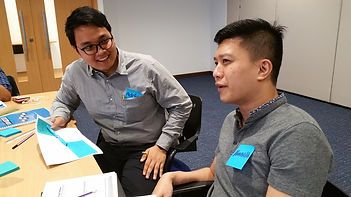
DESIGN THINKING
workshop
The Creative Approach to Problem Solving and Innovation.
Description
Design Thinking is a human-centered, iterative problem-solving process that leverages design-based techniques to gain insights and develop innovative solutions to any organizational or business challenge. To kickstart digital transformation, it's crucial to start with a Design Thinking workshop.
The five-phase Design Thinking process is based on the Hasso Plattner Institute of Design (the"d.school" of Stanford University) model, which has a proven track record of success. This methodology combines both analytical and creative approaches to generate solutions.
In this immersive two-day workshop, participants will work in small teams, guided by our expert design facilitators, to gain a customer-centric approach to problem-solving by re-imagining the end-to-end customer experience journey.
By participating in hands-on activities, participants will develop a range of essential skills such as ethnographic research, visual thinking, storytelling, and strategic planning. The workshop covers topics such as building empathy, ideation, prototyping, and testing new concepts, ensuring that participants leave with the tools and techniques to innovate effectively.




Recommended Audience
This course is designed for any business leader, professional, manager or individual contributor wishing to gain practical know-how on the principles, process and tools of Design Thinking.
Methodology
-
This is an experiential workshop, which emphasises engagement, interaction and practice.
-
Participants should expect short presentations that introduce content, examples, case studies, video presentations, group activities for skills practice, and group discussions for reflection that deepens their learning.
-
Participants will be given a challenge/project that requires them to work in teams to address one unmet need and present their ideas.
Learning Objectives
-
Acquire a deep understanding of the Design Thinking principles, process and tools.
-
Understand the mindsets of a design thinker.
-
Apply the Design Thinking framework as a structured process to solve problems.
-
Learn ideation techniques to generate breakthrough ideas and co-create an improved customer experience journey.
-
Improve personal effectiveness by becoming a more empathetic service provider.
Workshop Outline
1. Welcome & Icebreaker Activity
Objective: Start the workshop with an engaging icebreaker to build a positive atmosphere.
2. Introduction to Design Thinking
Objective: Familiarize participants with the foundational principles and key concepts of Design Thinking.
-
Traditional thinking versus design thinking
-
Three lenses of human-centred design: Desirability, feasibility, and viability
-
Benefits of design thinking
-
Examples and case studies of design thinking applications
-
The framework of design thinking and its impact on innovation and personal effectiveness
3. The Mindsets of a Design Thinker
Objective: Explore the fundamental mindsets of a Design Thinker that drive innovation and value creation.
-
Prioritizing people in the design process
-
Developing heightened process awareness
-
Embracing radical collaboration
-
Encouraging experimentation and iteration
-
Promoting visualization and reflection on actions
4. EMPATHIZE: Understanding the User
Objective: Acquire a deep understanding of the user's experience, context, and emotions, essential for effective design.
-
Gain insights into user experiences, situations, and emotions through observation and engagement techniques
-
Utilize tools like personas, empathy maps, and user feedback
5. DEFINE: Framing the Opportunity
Objective: Systematically process and synthesize research findings to craft a focused User Point of View (POV) that serves as a foundation for identifying user needs and insights.
-
Explore tools such as Point of View (POV), How Might We (HMW) questions, stakeholder maps, customer journeys, and context and opportunity maps
6. IDEATE: Exploring Ideas & Solutions
Objective: Focus on idea generation, translating problems into innovative solutions, and exploring a wide variety of ideas.
-
Emphasize creative problem-solving and generating out-of-the-box solutions
-
Employ divergent and convergent ideation methods
-
Utilize ideation techniques including sketches, prioritization matrices, affinity diagrams, and idea evaluation matrices
7. PROTOTYPE: Building & Visualizing Ideas & Solutions
Objective: Enhance understanding and interaction with ideas through tangible prototypes for quick and cost-effective development.
-
Create physical prototypes, wireframes, and storyboards to visualize concepts
8. TEST: Reviewing & Deciding Solutions
Objective: Seek user feedback on prototypes to gain insights, refine the user Point of View, and enhance solutions.
-
Utilize user feedback, observations, and evaluation matrices for refining and decision-making
Award of Certificate
Certificate of Attendance will be issued to participants who have attended at least 75% of the workshop
Duration
2 days
